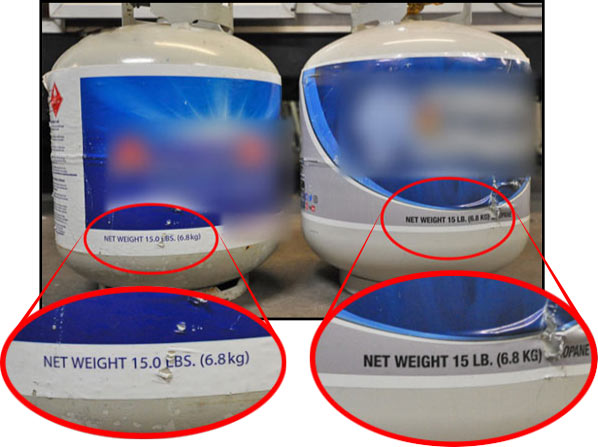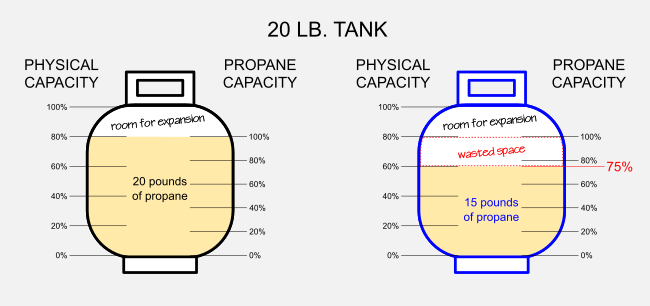Propane Capacity
"How long will one propane tank last?" is the most common propane related question we receive; followed closely by: "Does my camper need two propane tanks?" An internet search to answer these questions yields some information but also some misinformation, so hopefully this clears up a few things.
- How long will one propane tank last?
- Does my camper need two propane tanks?
- Propane exchange misinformation
How long will one propane tank last?
On (most) Flagstaff campers, four items require propane to operate:
- Furnace (19,000 BTU --"What's a 'BTU'?")
- Stove (3-burner stove - 16,900 BTU)
- Water heater (12,000 BTU)
- 3-way refrigerator* (1.9 cu ft - 819 BTU)
20 pounds of propane has 432,000 BTUs of energy. The furnace burns 19,000 BTUs of propane per hour*. So the furnace--running non-stop--will last for about 22 hours on one 20# tank. However, that's running non-stop. During the warmer times of year the furnace may be on only at night or early morning to take away a mountain chill; the thermostat regulating the furnace's operation will extend the use of one tank beyond 22 hours.
By comparison, a 1.9 cubic foot fridge needs just 819 BTUs per hour, so it could run on one 20-pound tank non-stop for over three weeks.
The numbers for the stove and water heater are a bit deceptive because they don't run in long intervals like the furnace and fridge might. The water heater turns on for 15-20 minutes to heat the tank of water initially, and then only for minutes at a time afterward to main the temperature.
Likewise, the stove's consumption of propane varies from meal to meal. Keep in mind the 16,900 BTU rating is for all three burners running for an hour.
With so many variables like what time of year you're camping in, your campground's elevation, how much hot water you need, how many meals you are cooking, what temperature you find comfortable, etc., it's tough to answer how much propane you'll actually need. However, generally, speaking one 20-pound tank should be good for about 1 1/2 weeks of basic summer camping.
In the shoulder seasons (or May in the mountains when it could still snow), one tank should last a long weekend. And for the brave campers who use their pop-up as a base camp for hunting or skiing, we recommend 4 or 5 20-pound tanks per week.
Does my camper need two propane tanks?
It depends. For week-long summer camping in eastern Colorado, one 20-pound tank should be sufficient. For a week in the mountains--even during the summer--with the furnace running more often, one tank might run out before the end of the trip. If you take mostly weekend trips, one tank is probably enough.
That said, if you find you're running out of propane too often a second tank might be good. If you have room on the tongue for an extra propane tank, the peace of mind knowing you have propane in reserve might be worth the extra expense and modification to have a second tank.
Here are your options for Extra Propane.
Please keep in mind a full 20-pound tank of propane weighs ~38 pounds, so if excessive tongue weight is a concern for your tow vehicle, adding a second tank to the tongue might not be as good as hauling a tank in the back of your tow vehicle.**
Propane exchange misinformation
Let's start with the conclusion: Why is "propane exchange misinformation" important? It's important because if this page says one 20-pound tank will run the furnace for 22 hours and--after using a propane exchange to get a "full" tank that has only 15 pounds of propane in it--you run out of propane at the 17-hour mark, you (and anyone camping with you) might be irate with us. And we don't want anybody to be irate with us.
Back to the start:
"A 20# tank does not hold 20# of propane--it can legally hold only 16-17 lbs." --camping forum user
This comment from the Great Interwebz is not true, but it's repeated enough that one might start to believe that it is. This misinformation may stem from some propane exchanges filling their tanks only partially-full: perhaps people think a "20-pound tank" only holds 15 pounds of propane because they've seen a lot of "15 lb." labels on the tanks and figure that's just what full "20# tanks" hold. (Kind-of like how a "2 x 4" stud does not measure 2 inches by 4 inches; we just call it a "2 x 4" and assume everyone knows it's actually 1 1/2" x 3 1/2".)
To be clear: a "20# propane tank" is designed to hold 20 pounds of propane safely.
When asked why their company fills 20-pound tanks with 15 pounds of propane, one propane exchange worker said: "A 20-pound tank needs 20% of its space reserved for 'expansion'--so the maximum propane filled is 80%." 80% of 20 is 16, not 15, so their excuse for not filling tanks all the way already falls flat, but let's see why 16 pounds is also not correct:
Although it's true propane tanks require 20% of their volume to be reserved for "expansion"--such that if the tank heats up and the propane expands it does not rupture*** the tank--that 20% has already been accounted for when building the tank. A 20-pound tank is designed to hold 20-pounds of propane and still have 20% of the total volume reserved for expansion.
Here's a diagram showing how a tank is designed to hold 20 pounds of propane (on the left) and how the propane exchange worker explained the extra "expansion" space (on the right). The required 20% expansion space involves 20% of the total volume of the tank, not 20% of the tank's propane capacity. In fact, filling the tank to only 15 pounds means it's holding only 75% of what it could hold.
Our purpose here is not to say propane exchanges are deceiving their customers. After all, the label clearly states "15 lbs" on the tank. We're simply trying to inform because for those who are running out of propane earlier than they could be and are looking for a solution, it's good to know the facts about propane capacity.
Maybe an extra tank is necessary. Maybe just filling one tank to its full capacity will get you through your usual weekend trip. Maybe two tanks filled to 75% is an acceptable trade-off because the propane exchange is right around the corner and the place that fills tanks all the way (like us or U-haul) are too far away to make it worth the drive.
Whatever the case, we're not trying to sell extra propane, we just want our customers to have the correct information and be able to equip their camper to suit their needs.
*Forest River's literature says the Flagstaff/Rockwood tent camper has a 20K BTU furnace. It's actually 19K BTU. It may not matter in practice, but we want things right for the record.
**By "back of your tow vehicle or camper" we are talking about an open-air truck bed or an open storage rack on the outside of a camper. Storing a propane tank in an enclosed space--even temporarily--is dangerous and not recommended. (back ![]() )
)
***Propane tanks have a "pressure relief valve" that opens if the pressure in the tank becomes too high and the tank is in jeopardy of rupturing. If the tank is overfilled (or a properly filled tank becomes seriously overheated), this pressure relief valve opens and releases propane to alleviate the pressure.
Additionally, since 2002, consumer propane tanks rangins from 4-pounds to 40-pounds must have an "OPD" --Overfill Prevention Device--that prevents filling a tank over the 80%-of-capacity limit.
(back ![]() )
)
![]() Back to Articles & Tutorials
Back to Articles & Tutorials
Privacy © 2009-2025 Roberts Sales. All rights reserved.



